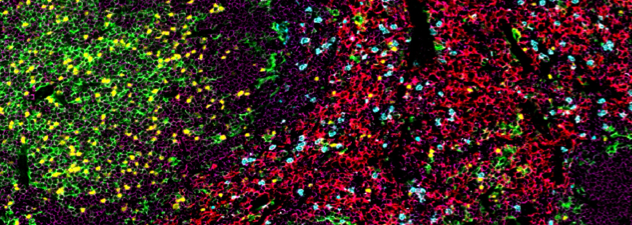Simplifying Multiplex IHC Panel Design for Spatial Biology

In spatial biology, multiplexing in immunohistochemistry (IHC) enables the simultaneous detection of multiple biomarkers within a single tissue section. This unravels insights into how cellular interactions influence the tissue microenvironment, deepening our understanding of disease progression and therapeutic responses.
SignalStar™ Multiplex IHC is a technology that uses antibodies, oligonucleotides, and fluorophores to interrogate cellular presence, location, function, and biomarker co-expression patterns. Multiple biomarkers can be amplified simultaneously in FFPE tissue with high sensitivity and specificity, providing results for up to eight biomarkers in two days.
You Don’t Need to Be a Spatial Expert
SignalStar mIHC panels combine CST scientific expertise, our high-quality antibodies, and rigorous validation into an easy-to-use solution that enables you to generate multiplex spatial images and deepen your understanding of biology, even when you’re not a spatial expert. So you can easily design experiments and get answers to your most pressing scientific questions—fast.
- Our automated SignalStar Multiplex IHC Panel Builder eliminates all the guesswork with panel design, letting you focus on results instead.
- CST validates and optimizes all panels for mIHC—so you don’t have to.
- Panels work out of the box, and on your existing fluorescent imaging instrumentation.
- Detect multiple up to 8 human or mouse biomarkers in 2 days—even those with low levels of expression.
- If your research needs change, it’s easy to redesign panels.
You can design a SignalStar mIHC panel specific to your needs, or reference human-reactive and mouse-reactive multiplex IHC panel designs curated by CST scientists.
Click on the panels below to learn more.
- Human Tumor Immune Microenvironment Panel
- Human T Cell Exhaustion Panel
- Human Myeloid Cell Function Panel
Human Reactive Panels
Human Tumor Immune Microenvironment Panel
Detect immune cell types in a human tumor microenvironment (TME).
Biomarker | Relevance |
|---|---|
Pan-Keratin | Epithelium (identifies tumor cells) |
CD3 | All T cells |
CD4 | Helper T cells |
CD8 | Cytotoxic T cells |
FoxP3 | Regulatory T cells |
CD68 | Macrophages |
CD11c | Dendritic cells |
CD20 | B cells |
Human T Cell Exhaustion Panel
Gain a comprehensive understanding of T cell dynamics within the TME.
Biomarker | Relevance |
|---|---|
Granzyme B | Cytotoxic potential of T cells |
CD3 | All T cells |
CD8 | Cytotoxic T cells |
CD4 | Helper T cells |
PD-1 | Stem-like T cells, exhausted T cells |
TIM3 | Exhausted T cells |
LAG3 | Exhausted T cells |
TCF1 | Stem-like T cells |
Learn More & View Key Features
Human Myeloid Cell Function Panel
Observe myeloid cells and relevant functional markers.
Biomarker | Relevance |
|---|---|
CD11b | Myeloid cells |
CD11c | M1-polarized macrophage |
CD68 | Macrophages |
CD206 | M2-polarized macrophage |
CD163 | M2-polarized macrophage |
HLA-DRA | M1-polarized macrophage |
XCR1 | Conventional DC1 (CD8 T cell antigen) |
CD86 | M1-polarized macrophage |
Mouse Reactive Panels
Mouse Tumor Immune Microenvironment Panel
Gain detailed insights into immune cell infiltration versus immune exclusion within the TME.
Biomarker | Relevance |
|---|---|
Pan-Keratin | Epithelium (identifies tumor cells) |
CD3 | All T cells |
CD8 | Cytotoxic T cells |
FoxP3 | Regulatory T cells |
F4/80 | Macrophages |
CD11b | Myeloid cells |
Ly6G | Neutrophils and MDSCs (myeloid-derived suppressor cells) |
CD19 | B cells |
Learn More & View Key Features
Mouse Myeloid Cell Function Panel
Observe myeloid cells and relevant functional markers.
Biomarker | Relevance |
|---|---|
CD11b | Myeloid cells |
F4/80 | Macrophages |
CD206 | M2-polarized macrophage |
CD86 | M1-polarized macrophage |
Arginase | M2-polarized macrophage |
Ly6G | Neutrophils and polymorphonuclear MDSCs |
SIRPɑ | Macrophage inhibitory receptor |
Technical Support
Visit the Technical Support page to search for troubleshooting information and answers to technical questions.
Cell Signaling Technology, CST, and SignalStar are trademarks of Cell Signaling Technology, Inc. All other trademarks are the property of their respective owners. Visit cellsignal.com/trademarks for more information.
U.S. Patent No. 10,781,477, foreign equivalents, and child patents deriving therefrom.
